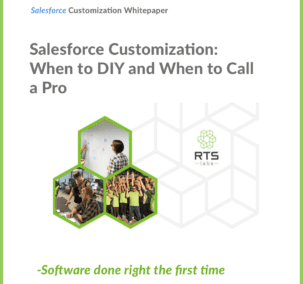3 Clues Your Salesforce Needs a Tune-Up

Remember when you first implemented Salesforce? It was a thrill!
Your old CRM system was creating a whole host of problems for you. It was difficult to set up the fields you needed for your sales team – and difficult to track if everyone was entering the right information. On top of that, it was hard to get your data to the implementation engineering teams. In fact, everything about your last CRM was bad. So, you switched to Salesforce with high expectations.
But a year later, the excitement has worn off. Salesforce isn’t getting you the results you thought it would. Something is “off,” but you’re not sure what or where to begin. Maybe you’re even wondering if your situation will ever improve…
Start looking for these three clues your Salesforce needs a tune-up – and then use these clues to lead you to a solution to get you and your team back on track with Salesforce.
Clue #1: No One Is Using Salesforce
The biggest clue your Salesforce is off track is that no one is using it. This means no one is taking ownership of the system. And ownership is the last thing that needs to fall into place at the end of a successful implementation.
An effective implementation begins with a careful assessment of your business requirements. The next step is to select an implementation team and plan milestones. This leads to the development of a process flow diagram. The result is a proper build-out. Finally, detailed documentation lets you confirm that you’re getting what you think you’re getting.
If you’ve implemented Salesforce correctly, including comprehensive user training to encourage adoption and a designated Salesforce Admin to coach and guide users, then ultimately Salesforce becomes your system of record. Based on a data model, you can now integrate third-party apps without a hitch, further customizing Salesforce’s capabilities for your own needs.
But, if Salesforce isn’t aligned with your goals or if you skipped steps (such as training), then people will find Salesforce hard to use – which means they aren’t as likely to use it. If people aren’t using Salesforce, that drastically reduces your ROI.
That doesn’t mean it’s too late! But it does mean you’ll probably want to go back and re-do certain steps or take time to do the steps you skipped.
Additional reading:
3 Reasons Your Sales Team Won’t Use Salesforce and What to Do About It
6 Characteristics of a Superstar Salesforce Admin
Clue #2: Your ROI Is Much Lower Than You Expected
Could cost-saving shortcuts be cutting into your ROI? Shortcuts may save you money up front, but too often they lead to downstream problems. For example, not taking the time to research your business processes and document and define your business goals during your Salesforce implementation makes if difficult to establish what your Salesforce requirements are and to align them with your goals. Proper due diligence (i.e., documenting and defining what you need Salesforce to do for you based on what you’re doing now and what your future goals are) will lead to a solid framework for creating something more than just a standard out-of-the-box CRM solution.
Be warned. Implementations based on low price usually end up costing you more in the long run. They rely on a one-size-fits-all approach. Your organization is unique and your Salesforce needs to fit like a glove to work right.
While Salesforce is not cheap, it’s much more expensive when it’s not implemented right. Don’t make this mistake. Hire a team with a holistic view of your business and with expertise in data, integration, and, of course, Salesforce. They should serve as subject matter experts (SMEs) for your business and have a background in the Salesforce platform. (And if they don’t start out as SMEs, they should listen and be willing to learn until they become SMEs to understand what you truly need out of Salesforce.)
Clue #3: Your Salesforce Won’t Talk to External Systems
It’s true what they say. Good things take time. The implementation team you hired promised a quick and easy implementation. You told them what you wanted (or what you thought you wanted), and they did what you asked. However, there were implications you weren’t aware of. And your implementation team didn’t notice or didn’t speak up. Now these issues have now come back to haunt you.
For example, when Salesforce is implemented right, it becomes your system of record. This means it’s the focal point for your external systems. As the system of record, Salesforce can send data outside or get data from outside systems, making it a much more powerful application.
When Salesforce is not your system of record, there’s the risk that some of your most important data, such as client updates, will accidentally be deleted when new data is entered. To make Salesforce your system of record, you need to create a data model.
If Salesforce wasn’t set up properly during implementation to work with your external systems – or if a lot has changed with your processes or systems, so what you did initially isn’t working well now – a Salesforce tune-up sooner rather than later could solve your current problems and avoid future ones.
Case Solved for Salesforce Success
You made the right decision to get Salesforce. Your sales and marketing teams now have the tools they need to compete in a modern marketing arena. But your Salesforce machine needs a tune-up.
A high-performance tool like Salesforce needs custom calibration to get high-performance results. At RTS Labs, we specialize in tune-ups for under-performing Salesforce implementations. So, give us a call just to start the conversation and see if there’s something we can do to help get you back on track.
